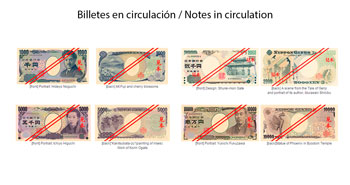Japanese yen exchange rate
WE SELL RATE HISTORY OF JAPANESE YEN
WE BUY RATE HISTORY OF JAPANESE YEN
JAPANESE YEN INFO
The Japanese Yen is the official currency of Japan.
Notes: 1000, 2000, 5000, 10000 yen
Coins: 1, 5, 10, 50, 100, 500 yen
Subunit: sen, rin
Code: JPY
Symbol: ¥, 円 or 圓
Main Exchanges
If you are going to visit Tokyo, Osaka or any other city of Japan you will need to exchange your Euros to Japanese Yen. In Eurochange you can buy your Japanese Yen at the best price and with total availability. Buy them now online or find the nearest exchange office with the service to buy currencies.
About Japanese Yen
The Yen is the official currency of Japan. Its ISO 4217 code is JPY and its symbol is ¥ while prices for marking the symbol is used 円.
History of the currency of Japan
The Yen was introduced in Japan in 1891. In those years the Spanish Dollar minted in the Colonies and other coins minted in the fledgling republics of Latin America circulated abundantly throughout Southeast Asia.
With the arrival of the Yen the old rather complex monetary system whose currency was the Mon was replaced. The Yen was established with a decimal system: Each Yen was divided into 100 Sen and 1,000 Rin, but these fractions are no longer used (they stopped being used in the year 1953) being currently the smallest monetary unit the coin of 1 Yen. Man is also used, which would be large quantities in multiples of 10,000. That is, 2 Man would equal 20,000 Yen, 3 Man would be 30,000 Yen, and so on.
Notes and coins of Japanese Yen
The Japanese Yen notes are 1,000, 2,000, 5,000 and 10,000 Yen. On the banknotes different illustrious figures of Japanese science and culture appear. In addition to emblematic places and representations of their culture.
JAPANESE YEN BANKNOTES IN CIRCULATION
On the 1,000-yen note appears Hideyo Noguchi, a leading bacteriologist and researcher who discovered the pathogen of neurosyphilis and a great researcher on yellow fever. On the back of the note appears Mount Fuji, one of Japan's best-known natural attractions.
On the 2,000-yen note, the Shurei-mon gate appears, the second gateway to Suri Castle in Okinawa Prefecture. It shows the Chinese influence in Japan and it was also the first part that began to restore the entire castle after the Second World War. On the back is a scene from the Genji Novel, a traditional Japanese novel considered the oldest in history.
On the 5,000-yen note, appears Ichiyō Higuchi, a Japanese story writer, is one of the first important women novelists in Japanese history. On the back is an image of the Kakitsubata-zu, a six-panel screen with Japanese irises drawn from the early seventeenth century.
On the 10,000-yen note, appears Yukichi Fukuzawa, considered one of the fathers of modern Japan. His ideas about occidental politics were very influential in the movement of the Meiji Enlightenment. On the back is an image of a Phoenix from the Byodoin Temple, located south of the city of Kyoto.
The Japanese Yen coins are 1, 5, 10, 50, 100 and 500 Yen. On the coins appear different specimens of native plants, such as a rice plant, some chrysanthemums, a bamboo plant and several cherry blossoms, and the Temple of Hōōdō (in Byodoin) in the 10 Yen coin.
Tips for traveling to Japan
If you are going to travel to Japan check out our post with 5 things to do in Tokyo.
How many Japanese Yens do I need for my trip to Japan?
If you do not know how to calculate the amount of Japanese Yens you need for your trip, it will be our pleasure to help you. Our customers usually take around 860 Euros in Japanese Yens. In order to make an approximate calculation of the amount of money you might need to take with you, you should take into account what kind of expenses you will have once you arrive in your destination. Whether you have to pay for hotels, excursions or entrance fees, or if you will only have the most basic expenses such as food, transportation or shopping.
Look for the closest office with this currency



